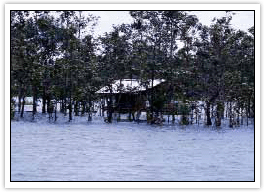2005 Progress Report
Flood Management and Mitigation Programme
The aim of the Flood Management and Mitigation Programme (FMMP) is to prevent, minimise and mitigate people’s suffering and economic losses due to floods, while also preserving the environmental benefits of yearly flooding.

The programme has five components:
- Establishment of a Regional Flood Management and Mitigation Centre (RFMMC) in Phnom Penh
- Structural Measures and Flood Proofing
- Mediation of Trans-boundary Flood Issues
- Flood Emergency Management Strengthening
- Land Management
The heart of the programme is a Regional Flood Centre, which provides technical and coordination services to the four countries in the Lower Mekong Basin.
The programme’s components are involved in undertaking policy discussions on land use planning and infrastructure development in relation to flood impacts; implementing flood proofing measures; providing transboundary mediation services; performing analyses of risks and impacts; and strengthening the region’s capacity to manage flood emergencies.
The FMMP went through a preparatory phase in the first half of 2005 with the opening of an interim Regional Flood Management and Mitigation Centre (RFMMC) in Phnom Penh, Cambodia in April 2005, marking its key achievement. In June 2005 the flood forecasting function was transferred from the MRC Secretariat (MRCS) in Vientiane, Lao PDR to the new RFMMC, ready for the 2005 flood forecasting season.
In 2005 the programme also signed the agreement concerning the operations of the RFMMC with the Cambodian Government. Construction of a permanent centre will begin in 2006 and completion is scheduled for 2007.
A series of achievements in 2005 have established a good base for the programme’s future success.
- The programme has hired key staff including a Chief Technical Advisor, a Programme Coordinator, a Senior Flood Management Specialist and an Operations Manager for the RFMMC. It will continue this process in 2006 until it is fully staffed.
- A Draft Programme Implementation Plan was prepared and sent to the National Mekong Committees (NMCs). The programme also prepared a draft of a framework for development and implementation of Integrated Flood Risk Management guidelines for the Basin Development Plan and a proposal for the flood risk mapping pilot project for the 2T sub-basin in Thailand.
- In April 2005, more than 120 participants from around the world attended the Third Annual Mekong Flood Forum in Vientiane, Lao PDR. The theme of ‘Flood Management and Mitigation’ was based on the launch of the new FMMP and feedback from participants has been integrated into operations.
- Work commenced on what will be the first MRC Annual Flood Report of the Lower Mekong Basin, to be released in 2006.
Acheivements for Component 4, implemented by MRC and GTZ together with the Asian Disaster Preparedness Center (ADPC), include:
- Completion of collection of baseline and other relevant data for the finalisation of a logframe document. Project Managers and National Coordinators are now on board.
- Completion of a study of the roles and responsibilities of various government agencies in Kandal and Prey Veng provinces in Cambodia as part of its emergency management efforts. Establishment of an office in Prey Veng and recruitment of a National Coordinator.
- Organisation of workshops for provincial disaster management personnel and continuing collaboration with the ADPC on a second phase of Capacity Building for Preparedness Through the Use of Flood Information Products in the LMB.
- The Disaster Preparedness arm of the EC Humanitarian Organisation (DIP-ECHO) conducted flood preparedness training courses for officials at district and community level.
Achievements for Component 5 include:
- The establishment of an office within the MRC Secretariat, employment of national coordinators in Cambodia and Viet Nam and start-up meetings held with the NMCs in Cambodia and Viet Nam (jointly with Component 4). In Viet Nam, An Giang and Dong Thap provinces have been selected for field activities, while in Cambodia Kandal and Takeo provinces have been selected.
- Discussions with counterparts involved in land management and collection of baseline data have been held in order to produce flood probability maps for the pilot sites. Initial work for technical training is underway.
During 2005 work continued on the USAID/Office of Foreign Disaster Assistancefunded project “Provision of Flood Early Warning to Flood Vulnerable Communities in the Lower Mekong Basin, Phase: Cambodia and Lao PDR. Now entering its fourth year in Cambodia, the project is working with the American Red Cross and Action Contre La Faim in 40 villages in four flood-prone provinces.
In 2006 the project will also launch its activities in the Lao PDR, working with the National Disaster Management Office and other relevant line agencies. Five vulnerable villages in Champassak Province will be the pilot sites and various activities will be carried out in preparation for the 2006 flood season, including field surveys and installation of flood marks and village billboards.
The project to establish the Mekong Hydrological Cycle Observing System (Mekong- HYCOS) was endorsed by all member countries and funding has been secured. It has been decided that Mekong-HYCOS will become part of the MRC’s Information and Knowledge Management Programme.
In addition to moving forward with the new RFMMC in 2006, the programme will focus on establishing national flood management and mitigation units located at NMCs; improving monitoring and forecasting operations; compiling an inventory of existing and planned flood-related infrastructure; and establishing a mediation and coordination section to deal with trans-boundary flood issues.
Choose a newsletter: